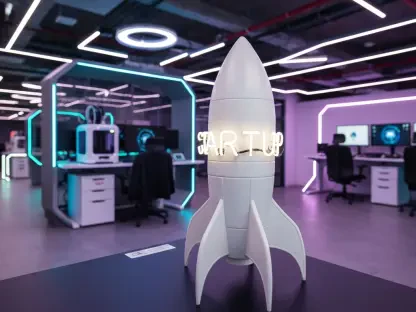The SaaS Industry and the Cost-Quality Challenge
The Software-as-a-Service (SaaS) industry stands at a pivotal moment, with global demand for digital solutions surging at an unprecedented pace, driven by businesses across sectors increasingly relying on SaaS platforms to boost efficiency, scalability, and remote collaboration. This results in a market that continues to expand rapidly. However, this growth comes with intense pressure to deliver innovative, high-quality products while keeping development costs in check, a balancing act that often strains resources and challenges profitability.
Economic constraints compound these difficulties, as SaaS companies grapple with rising operational expenses and the need to stay competitive in a crowded field. The expectation to roll out frequent updates and maintain top-tier user experiences adds further complexity, pushing organizations to seek transformative solutions. Artificial intelligence (AI) emerges as a critical ally in this scenario, offering the potential to streamline processes, reduce expenditures, and elevate output without sacrificing standards.
Key market players are already leveraging AI technologies, including generative AI and large language models (LLMs), to redefine development paradigms. These tools not only promise cost-efficient innovation but also enable faster time-to-market, a crucial advantage in today’s fast-paced environment. As technological influences reshape the landscape, the focus on integrating AI becomes a strategic imperative for those aiming to maintain relevance and drive sustainable growth.
AI as a Game-Changer in SaaS Development
Key Trends Driving AI Adoption
AI’s transition from a speculative concept to a practical tool marks a significant shift in the SaaS sector. No longer confined to experimental labs, AI is now embedded in everyday workflows, assisting with tasks ranging from coding to customer engagement. This evolution reflects a broader acceptance of intelligent systems as essential components of modern software development.
Emerging tools such as GitHub Copilot and Dialogflow are setting new benchmarks for productivity and efficiency. These platforms automate repetitive functions, allowing developers and support teams to focus on higher-value activities. Meanwhile, business needs are evolving, with an emphasis on pairing cost reduction with quality improvement, a demand that AI is uniquely positioned to meet through context-aware, adaptive solutions.
Competitive pressures and the push for accelerated development cycles are also fueling AI adoption. Companies recognize that staying ahead requires embracing technologies that shorten timelines and enhance agility. This dynamic creates fresh opportunities for innovation, positioning AI as a cornerstone of strategic planning in the SaaS domain.
Data and Projections on AI Impact
Industry research underscores AI’s transformative potential, with McKinsey estimating productivity gains of 20-45% in software engineering through generative AI applications. Real-world examples further validate these figures, with reports indicating up to 30% reductions in coding time and 35% cost savings in customer support operations. These metrics highlight the tangible benefits of integrating intelligent systems into core processes.
Looking ahead, forecasts suggest that AI will play an even larger role in scaling SaaS operations over the next decade. Broader adoption and deeper integration into workflows are expected, with tools becoming more sophisticated and tailored to specific needs. This trajectory points to a future where AI is not just an option but a fundamental driver of efficiency.
Performance indicators such as reduced first-response times in support and improved customer satisfaction (CSAT) scores serve as critical benchmarks for success. These metrics provide a clear measure of AI’s impact, demonstrating how it can enhance both operational outcomes and user experiences. As adoption grows, tracking such indicators will be essential for validating investments and refining strategies.
Overcoming Barriers to AI Integration in SaaS
Adopting AI in SaaS development is not without hurdles, particularly given the technological limitations of current tools. Many solutions still require significant human oversight to ensure accuracy and relevance, underscoring the need for a balanced approach. Addressing these gaps is crucial to unlocking the full potential of AI in complex development environments.
Market-driven challenges also pose obstacles, with resistance to change among teams often slowing progress. Additionally, there is a risk of over-reliance on automation, which can lead to diminished critical thinking or oversight in key areas. Tackling these issues demands a cultural shift, alongside robust training and change management initiatives to foster acceptance.
Solutions lie in starting with low-risk pilot projects that allow companies to test AI’s impact without overcommitting resources. Focusing on measurable outcomes builds trust and momentum, demonstrating value to skeptical stakeholders. Aligning AI tools with specific business bottlenecks ensures relevance, maximizing effectiveness while minimizing disruption to existing workflows.
Navigating Data Security and Compliance in AI Adoption
The regulatory landscape surrounding AI use in SaaS is intricate, shaped by stringent data privacy laws and industry-specific standards. These frameworks demand careful consideration, as non-compliance can result in severe penalties and reputational damage. Navigating this terrain requires a proactive approach to ensure that innovation aligns with legal obligations.
Security remains a paramount concern, especially in regulated sectors where data breaches can have catastrophic consequences. AI tools must prioritize robust protection mechanisms to safeguard sensitive information and maintain customer trust. This focus is non-negotiable, as any lapse can undermine the benefits of technological advancements.
Regulatory changes continue to influence SaaS practices, necessitating strategic planning to balance innovation with compliance. Companies must stay abreast of evolving requirements, integrating them into AI deployment strategies. This proactive stance not only mitigates risks but also positions organizations as trusted leaders in a data-conscious market.
The Future of AI in SaaS Development
AI’s long-term potential to reshape the SaaS industry is immense, with emerging tools and technologies poised to drive unprecedented change. Increasingly sophisticated models promise to enhance real-time innovation, enabling platforms to adapt swiftly to user needs. This capability will redefine how SaaS products are conceptualized and delivered.
Market disruptors, including advanced AI algorithms, are set to challenge traditional development approaches. These innovations empower companies to experiment and iterate at a faster pace, fostering a culture of continuous improvement. As a result, the ability to stay agile will become a defining factor in maintaining a competitive edge.
Shifting consumer preferences toward faster, more personalized SaaS solutions are also driving investment in AI. Coupled with global economic conditions, the push for efficiency through intelligent systems becomes a vital growth area. Companies that capitalize on these trends will likely emerge as frontrunners in an increasingly dynamic landscape.
Conclusion: Harnessing AI for Sustainable SaaS Growth
Reflecting on the insights gathered, it becomes evident that AI holds the power to reduce SaaS development costs by 30-45% in targeted areas while upholding or even enhancing quality. The strategic implementation of these tools proves to be the foundation of successful adoption, ensuring they align with specific business needs and team preparedness.
Looking back, the journey underscores the importance of measured investment in AI, with a focus on achieving clear, quantifiable returns. SaaS companies are encouraged to prioritize scalable solutions that can grow with their operations, setting a path for sustained efficiency. This approach helps mitigate risks and maximizes the impact of technological integration.
As a final consideration, early adopters who navigate these challenges effectively position themselves as industry leaders. The emphasis shifts to building on these foundations by exploring deeper AI integrations and fostering a culture of innovation. This forward-thinking mindset promises to sustain growth and competitiveness in an ever-evolving market.









